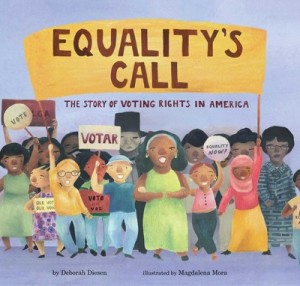The journey’s not over. The work hasn’t ended. Democracy’s dream must be constantly tended.
CLASSROOM AND TEACHING RESOURCES:
Democracy is a year round topic! Equality’s Call can be used in many ways in the classroom, at any grade level. The following are some free resources for classroom and home use:

- STATE-SPECIFIC CURRICULUM CONNECTIONS – Several years ago, I worked on a series of state-specific handouts that show how Equality’s Call and the topic of voting rights connect to state social studies standards and curriculum. While the list is somewhat out of date (and it might be a while before I get back to revising the handouts), the general idea of the series is that there are many ways to clearly connect a book such as Equality’s Call to state standards in your state. Click here to see the guides.
- CURRICULUM GUIDE — A free Equality’s Call curriculum guide created by my publisher, Simon & Schuster/Beach Lane Books.
- GERRYMANDERING EXPLAINED – a video to help students understand gerrymandering – available on YouTube, Facebook, and on my blog
- GAME – Voting Rights “Chutes and Ladders” style game (appropriate for all ages, and could be a fun activity for some older Reading Buddies to do with a younger class after reading the book together)
- HANDOUTS and WORKSHEETS – free educational activity sheets
- How will you answer equality’s call? [preK and early-elementary]
- Who’s your voting rights hero? [preK and early-elementary]
- The Voting Process [elementary to HS]
- In-Person Voting [elementary to HS]
- Voting Barriers and Solutions [elementary to HS]
- Compare voting in your state to voting in other states [upper elementary to HS] – also available in Word
- Interview an elections official to learn about voting in your state and community [upper-elementary to HS] – also available in Word
- CLASSROOM POSTER – Free classroom poster about voting – click link to view or to download and print.
- LESSON PLANS – The lesson plans were written by early childhood educator Karen Keesling. Each lesson plan includes virtual learning adaptations.
STUDENTS:
You’re never too young to help strengthen our democracy! Make sure the adults you know are registered to vote, and ask to go to the polls with them when they vote. Learn more about voting, and then use your voice to speak up for voting rights.
OLDER STUDENTS:
Learn about voting rights, and then share what you know at school and in groups you’re involved with. Help the adults in your life better understand voting rights and the barriers that exist to voter participation. Read stories to younger kids using Equality’s Call or other picture books about voting rights. Use your voice to advocate policy changes to politicians.
LIBRARIANS and BOOKSELLERS:
An Equality’s Call story time pairs nicely with a voter registration drive at your library or bookstore!
PARENTS:
Teach your kids about voting rights past and present, and learn more as you explore the topic together. And get involved! When kids see grown-ups speaking up about voting rights, it helps prepare them to be informed and active citizens. You are your child’s first civics teacher.
POLITICIANS & PUBLIC FIGURES:
Be a voting rights ambassador and educator by holding a voting rights story time at a local school or library using Equality’s Call and/or other books about voting rights. You are a hero to the kids in your community, so use that recognition factor to educate and inspire them! If you’re not sure how to go about holding a story time, email me for ideas, or just stop by your local library and talk to one of the children’s librarians.
I welcome your suggestions and input about this page. Thank you for standing up for our right to vote!